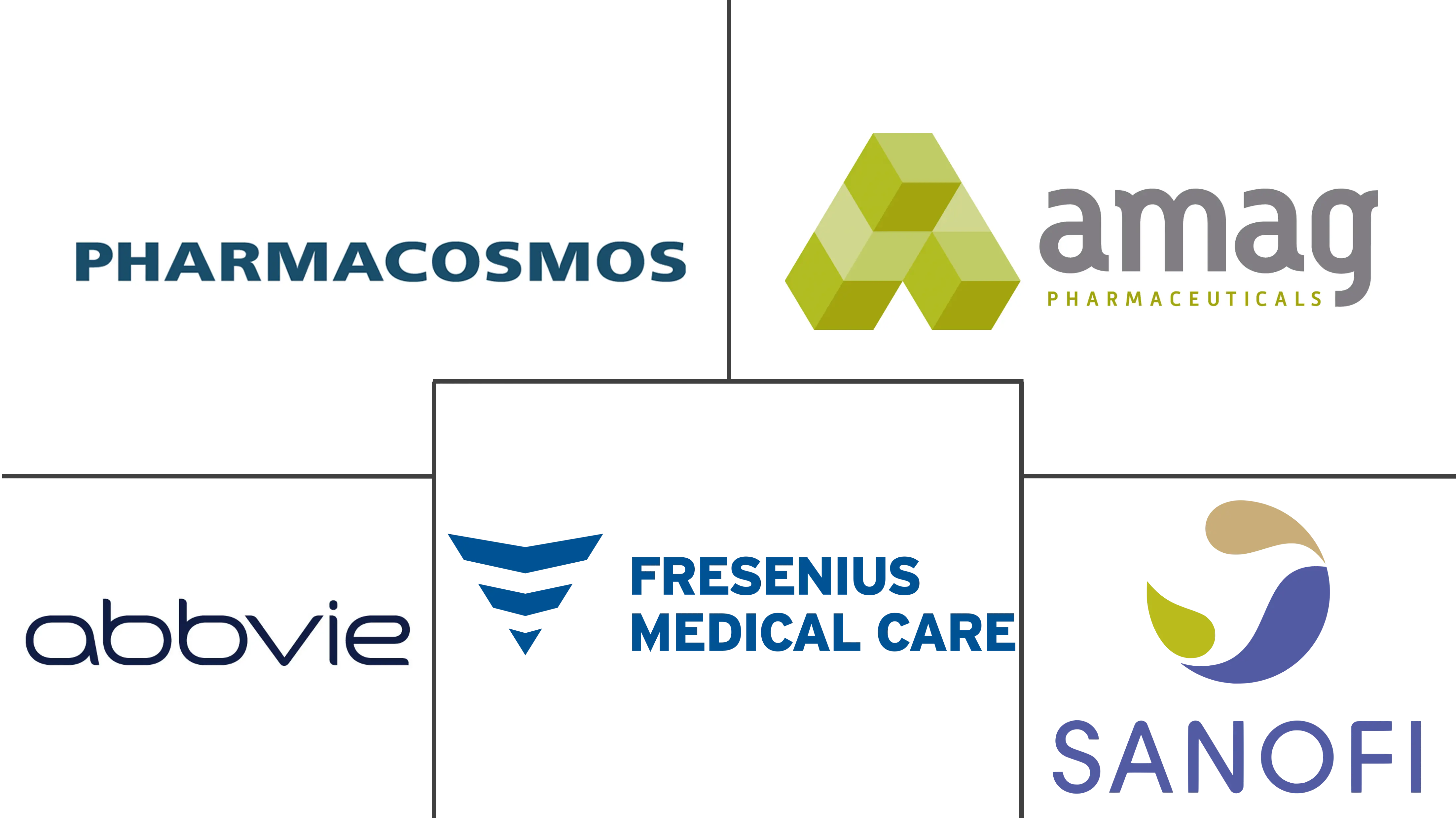Iron Deficiency Anemia Therapy Market Size and Share
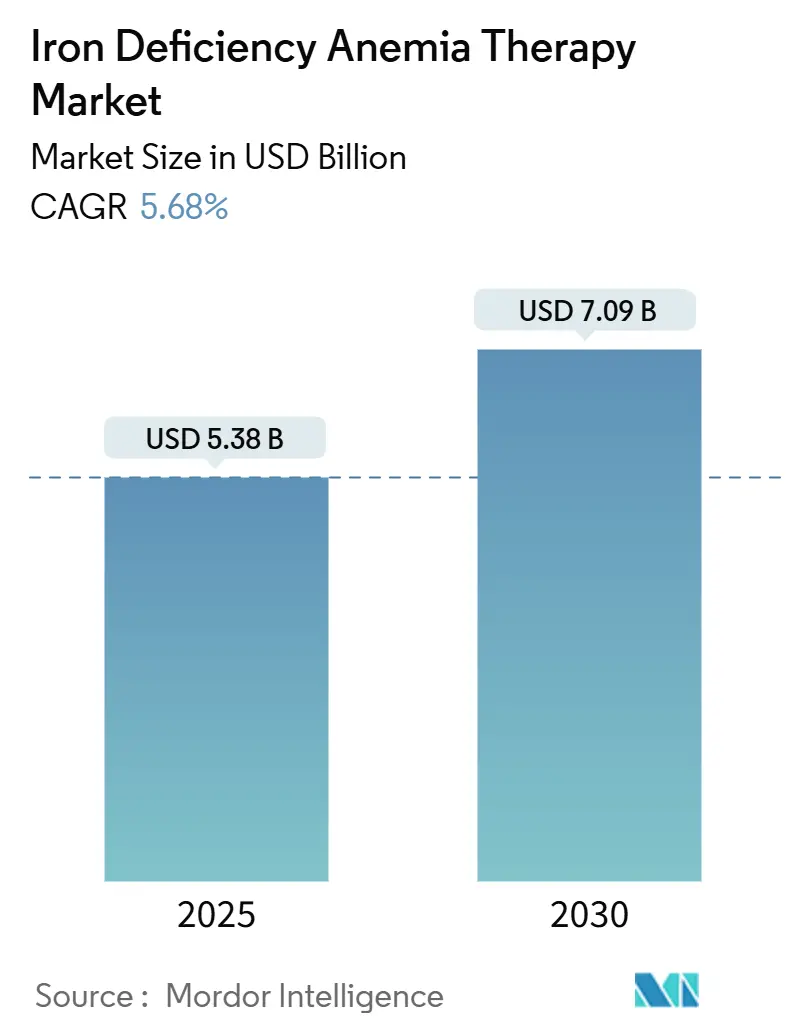
Iron Deficiency Anemia Therapy Market Analysis by Mordor Intelligence
The Iron Deficiency Anemia Therapy Market size is estimated at USD 5.38 billion in 2025, and is expected to reach USD 7.09 billion by 2030, at a CAGR of 5.68% during the forecast period (2025-2030). Strong clinical evidence for intravenous iron in heart failure, chronic kidney disease, and oncology, coupled with widespread screening programs, continues to lift demand. Record numbers of women of reproductive age and children now meet diagnostic criteria for deficiency, and this epidemiological pressure is translating directly into higher treatment volumes. Hospitals are favoring single-visit total-dose infusions that reduce chair time, while digital platforms are guiding dose decisions remotely. On the supply side, new oral technologies that wrap iron in protective matrices are improving adherence and opening consumer-centric sales channels that were once inaccessible to parenteral products.
Key Report Takeaways
- By therapy type, parenteral iron therapy commanded 61.32% of iron deficiency anemia therapy market share in 2024; oral iron is projected to expand at a 7.54% CAGR through 2030.
- By age group, adults represented 65.85% of the iron deficiency anemia therapy market size in 2024, while pediatrics is the fastest riser at a 6.74% CAGR to 2030.
- By distribution channel, hospital pharmacies held 52.23% revenue share in 2024; online channels show the quickest advance at 7.97% CAGR through 2030.
- By geography, North America led with 37.45% revenue in 2024; Asia Pacific is set to grow at 7.47% CAGR to 2030.
Global Iron Deficiency Anemia Therapy Market Trends and Insights
Drivers Impact Analysis
| Driver | (~) % Impact on CAGR Forecast | Geographic Relevance | Impact Timeline |
|---|---|---|---|
| Increasing global iron-deficiency anemia prevalence | +1.8% | Global, highest in Asia Pacific and Sub-Saharan Africa | Long term (≥ 4 years) |
| Integration of iron therapy into chronic-disease care pathways | +1.2% | North America and EU, expanding to Asia Pacific | Medium term (2-4 years) |
| Government anemia-elimination programmes | +0.9% | Asia Pacific core, spill-over to MEA and Latin America | Medium term (2-4 years) |
| Digitalized IV-dosing protocols reducing clinic time | +0.7% | Global, led by North America and Western Europe | Short term (≤ 2 years) |
| Emergence of trans-mucosal and transdermal delivery formats | +0.6% | North America and EU, gradual global expansion | Medium term (2-4 years) |
| Guideline shift to mandatory ferritin screening in heart-failure surgery | +0.4% | Global, early adoption in developed markets | Short term (≤ 2 years) |
| Source: Mordor Intelligence | |||
Increasing Global Iron-Deficiency Anemia Prevalence
Nearly 29.9% of women aged 15-49 and 39.8% of children worldwide live with iron deficiency anemia, equating to close to 2 billion potential therapy candidates. National surveys in South and Southeast Asia place prevalence for women as high as 63% in the Maldives. Rapid urbanisation has shifted diets toward lower iron density, while infectious disease loads continue to impede absorption. The resulting clinical burden sustains baseline demand for the iron deficiency anemia therapy market, even before accounting for chronic disease comorbidities. Longer-term demographic trends indicate sustained growth in high-risk groups, meaning underlying prevalence will remain the most powerful volume driver across forecast years.
Integration of Iron Therapy into Standard Care Pathways for Chronic Diseases
Cardiology, nephrology, and oncology guidelines now mandate ferritin screening and proactive replenishment, materially enlarging the treated population. The IRONMAN trial confirmed significant haemoglobin gains among heart-failure patients receiving ferric derisomaltose versus standard care. [1]Source: K. Docherty et al., “Intravenous iron for heart failure: the IRONMAN trial,” European Heart Journal, academic.oup.com Similar momentum is visible in oncology, where intravenous ferric carboxymaltose achieved 52.1% haemoglobin response in solid-tumour patients compared with 32.9% for usual care. These recommendations create predictable, protocol-driven purchasing that supports premium formulations and stabilises reimbursement.
Government Anemia-Elimination Programmes
Public-health campaigns inject sizable procurement budgets into the iron deficiency anemia therapy market, but outcomes remain mixed. India’s Anemia Mukt Bharat illustrates the scale: despite large-volume tenders for iron–folic acid, compliance gaps limit clinical impact. Policy makers are now pivoting toward better diagnostics and higher-intensity intravenous regimens for severe deficiency, favouring manufacturers able to offer differentiated dosage forms. Similar initiatives across ASEAN and parts of Africa follow this trajectory, building multi-year demand pipelines for both oral and parenteral products.
Digitalised IV-Dosing Protocols Reducing Clinic Time
Single-visit total-dose infusions have cut average chair time by more than half, and algorithm-based calculators embedded in hospital software further streamline scheduling. Remote ferritin self-tests from companies such as Luma Health and Preventis are letting physicians confirm iron status without in-person labs, enabling earlier intervention. These advances lower the logistical barriers that once limited parenteral adoption outside tertiary centres. As platforms mature, dosing precision is expected to improve, supporting broader outpatient use and strengthening overall volumes for the iron deficiency anemia therapy market.
Restraints Impact Analysis
| Restraint | (~) % Impact on CAGR Forecast | Geographic Relevance | Impact Timeline |
|---|---|---|---|
| Safety and tolerability concerns discouraging long-term adherence | -0.8% | Global, higher impact where healthcare infrastructure is limited | Long term (≥ 4 years) |
| Stringent pharmacovigilance requirements for parenteral iron | -0.6% | North America and EU, expanding globally | Medium term (2-4 years) |
| Diagnostic ambiguity between functional and absolute iron deficiency | -0.5% | Global, higher impact in emerging markets | Medium term (2-4 years) |
| API supply bottlenecks for ferric derisomaltose | -0.3% | Global, concentrated impact on specific product lines | Short term (≤ 2 years) |
| Source: Mordor Intelligence | |||
Safety and Tolerability Concerns Discouraging Long-Term Adherence
Gastrointestinal side effects still cause dropout for legacy ferrous salts, and hypersensitivity events, though rare, remain front of mind with intravenous products. Real-world audits show hypersensitivity in 3.1% of ferric derisomaltose recipients.[2]Source: A. Smith et al., “Real-world evaluation of an intravenous iron service,” Scientific Reports, nature.com Advanced oral options such as ferric maltol reduce discontinuations to under 5%, yet payer awareness is still catching up. The development of nano-encapsulated and transdermal delivery systems aims to remove these tolerability hurdles, but until such formats scale, adverse-event reluctance will weigh on uptake.
Stringent Pharmacovigilance for Parenteral Iron
Regulators have tightened post-marketing surveillance, mandating robust infusion protocols and detailed adverse-event reporting. These requirements increase compliance costs and slow product roll-outs, especially in smaller care settings that lack infusion infrastructure. The heightened scrutiny protects patient safety yet may discourage smaller players from entering the iron deficiency anemia therapy market, limiting competitive price pressure in certain geographies.
Segment Analysis
By Therapy Type: Evolving Balance Between Intravenous and Oral Solutions
Parenteral iron delivered 61.32% of iron deficiency anemia therapy market size in 2024, reflecting hospital reliance on total-dose infusions for severe cases. Total-dose options such as ferric carboxymaltose enable complete repletion in a single visit, which aligns with value-based care metrics that reward shorter length of stay. Ongoing hospital formulary expansions, alongside protocol integration for heart failure and oncology, anchor this dominance. However, raw-material tightness for ferric derisomaltose APIs has sparked selective shortages, highlighting latent vulnerability on the supply side.
Oral products post the swiftest expansion at a 7.54% CAGR. Ferric maltol and iron-whey-protein microspheres drive this upswing by slashing common gastrointestinal complaints that once undermined adherence. As adherence rates exceed 80% in recent trials, payers are reconsidering step-therapy rules that previously required failure on generic ferrous sulphate. This policy shift could accelerate volume migration toward premium oral brands over the forecast horizon, diversifying revenue streams inside the iron deficiency anemia therapy market.
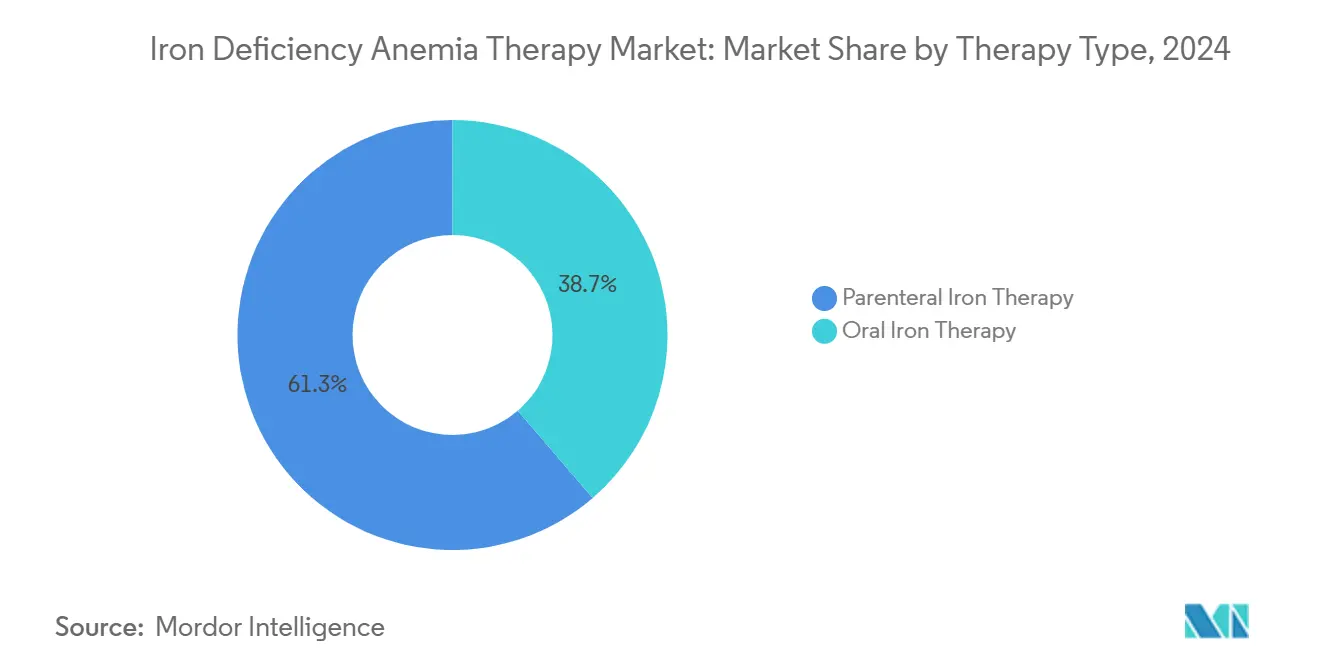
Note: Segment shares of all individual segments available upon report purchase
By Age Group: Stable Adult Core and Accelerating Pediatric Opportunity
Adults delivered 65.85% of the iron deficiency anemia therapy market share in 2024 on the back of routine screening in antenatal care, nephrology, and cardiology. Insurance coverage in developed markets routinely reimburses both oral and intravenous modalities, ensuring steady baseline demand. Newly issued heart-failure guidelines that classify iron deficiency as a treatable comorbidity further entrench adult utilisation, converting cardiology clinics into repeat procurement hubs.
Pediatrics records a 6.74% CAGR thanks to mandated newborn and school-age screening plus the arrival of child-friendly dose forms. Recent European paediatric consensus endorses weight-based ferric carboxymaltose from 1 year of age, widening the treatable pool. Improved palatability and dosing flexibility in oral suspensions, along with emerging data on neurodevelopmental benefits, strengthen the case for early treatment, positioning the segment as a long-run growth engine within the iron deficiency anemia therapy market.
By Distribution Channel: Hospital Strength Meets Digital Upswing
Hospital pharmacies accounted for 52.23% of iron deficiency anemia therapy market size in 2024, a figure underpinned by bundled care pathways that fold iron infusions into dialysis, chemotherapy, and heart-failure visits. Infusion-chair efficiency gains and tight pharmacovigilance workflows keep hospitals central to parenteral volume.
Online channels record 7.97% CAGR as direct-to-consumer self-testing converges with subscription delivery of advanced oral formulations. Telehealth protocols that link ferritin results to personalised refill algorithms have slashed barriers to initiation. While regulatory clarity on prescription iron varies across markets, the share of home-managed therapy is set to climb, chipping away at retail pharmacy dominance and injecting new competition into the iron deficiency anemia therapy market.
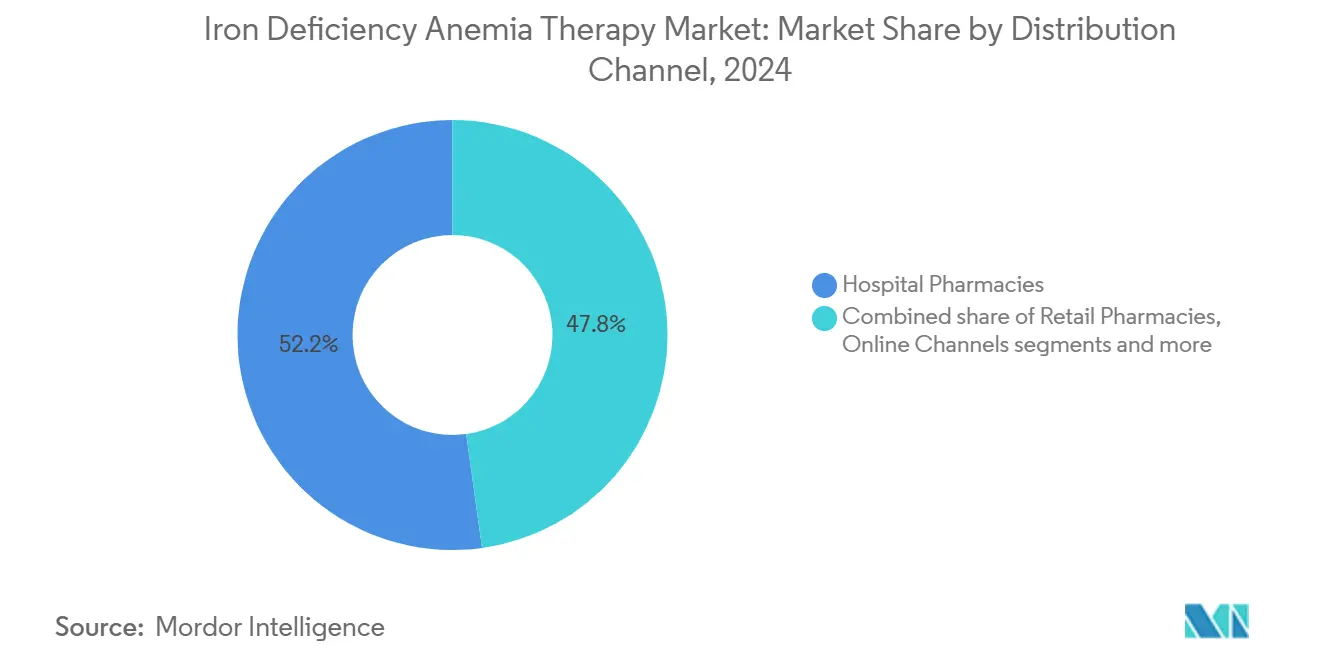
Note: Segment shares of all individual segments available upon report purchase
Geography Analysis
North America retained 37.45% of global revenue in 2024, buoyed by comprehensive reimbursement that covers both standard infusions and newer oral brands. Widespread adoption of single-visit ferric carboxymaltose and ferric derisomaltose regimens has reduced outpatient visits, freeing capacity in overstretched clinics. Canada’s recent authorisation of ferric carboxymaltose for paediatric use extends addressability across the life course. Mexico’s public-health insurers are piloting bundled anaemia management packages, though infrastructure limits infusion penetration outside metropolitan hubs.
Asia Pacific posts the fastest regional CAGR at 7.47%. Japan showcases sophisticated dosing algorithms that have shifted clinicians from saccharated ferric oxide to ferric carboxymaltose for efficiency gains.[3]Source: Y. Tanaka et al., “Clinical management of iron deficiency anemia in Japan,” International Journal of Hematology, link.springer.com Australia’s primary-care lobby estimates Medicare coverage for GP-led infusions could save USD 124 million in system costs, a proposal now under active review.
Europe maintains steady expansion on the back of guideline harmonisation and supply-security strategies that favour multiple API sources. Germany, France, and the Nordic markets deploy national registries to monitor infusion safety, reinforcing physician confidence in parenteral solutions. Eastern European countries, supported by EU health-equity funds, are scaling up paediatric supplement programs, creating new frontiers for the iron deficiency anemia therapy market even as mature Western states focus on chronic-disease integration.
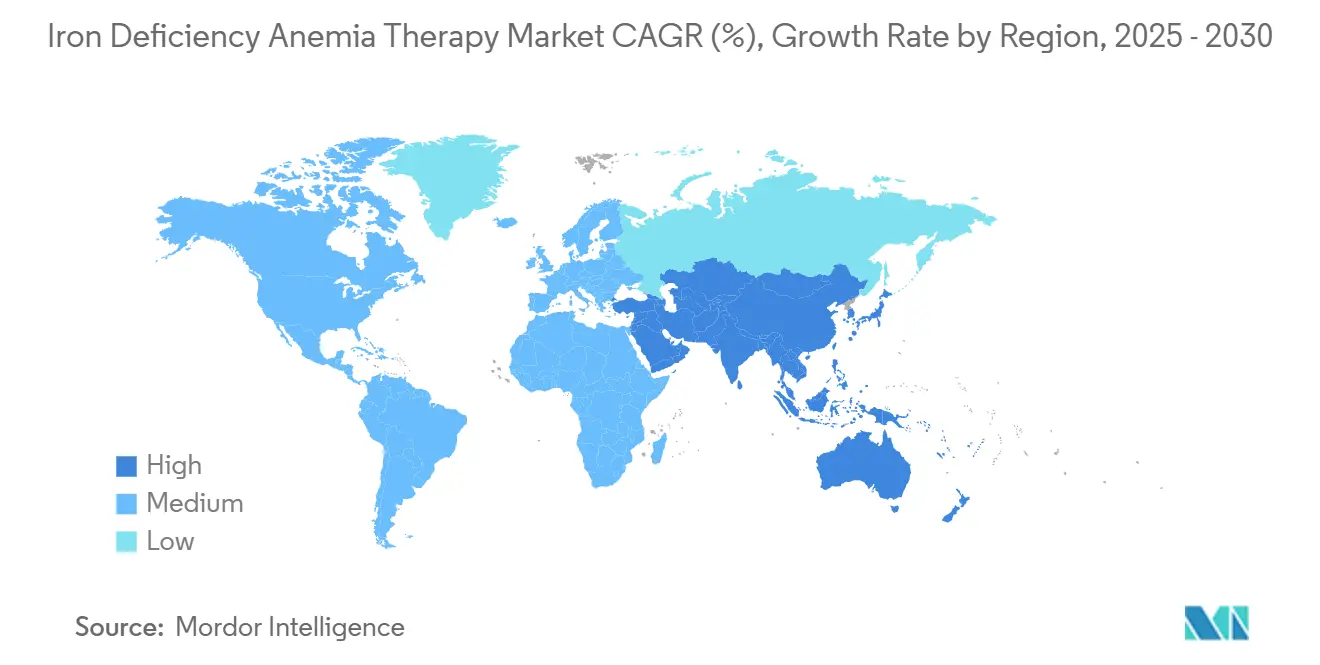
Competitive Landscape
The iron deficiency anemia therapy market remains moderately fragmented. AMAG (-Covis), Pharmacosmos, and Sanofi are the key players leveraging robust clinical datasets and manufacturing scale. Pharmacosmos’ 2024 acquisition of G1 Therapeutics broadened its oncology pipeline, reinforcing competitive positioning.
Innovation is clustering around delivery improvements. Nano-encapsulated iron and plant-protein complexes promise 90% bioavailability without gastrointestinal distress, supported by early-stage funding rounds involving venture and strategic investors. Digital companion apps that track ferritin, calculate cumulative dose, and auto-reschedule infusions aim to lock in brand loyalty. Geographic partnerships are also intensifying: Fresenius and Vifor expanded their China alliance, combining local dialysis reach with premium infusion lines.
Price pressure from emerging biosimilar-adjacent entrants is muted for now because of high validation costs and strict pharmacovigilance rules. Nonetheless, supply-chain diversification, modular production plants, and risk-sharing contracts with payers are growing priorities among incumbents as they seek margin stability in the evolving iron deficiency anemia therapy market.
Iron Deficiency Anemia Therapy Industry Leaders
-
AbbVie Inc.
-
Pharmacosmos
-
AMAG (-Covis)
-
Sanofi
-
Fresenius SE
- *Disclaimer: Major Players sorted in no particular order
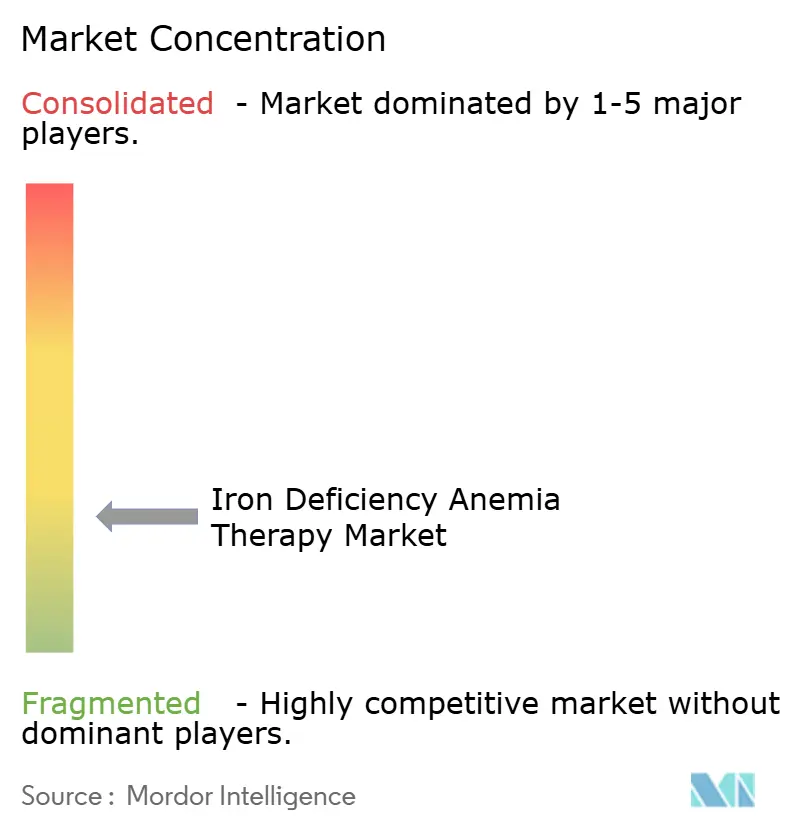
Recent Industry Developments
- March 2025: Kye Pharmaceuticals began nationwide Canadian distribution of ACCRUFeR (ferric maltol), the only prescription-only oral iron therapy for adults intolerant to standard preparations.
- March 2024: Cadila Pharmaceuticals launched Redshot FCM, a next-generation ferric carboxymaltose injection for adults and children over one year.
- March 2024: CSL Vifor received Health Canada approval for Ferinject (ferric carboxymaltose) in adults and paediatrics, marking its 87th country authorisation.
- May 2023: Emcure Pharmaceuticals introduced Orofer FCM 750, expanding its parenteral iron franchise with a convenient dosage variant.
Research Methodology Framework and Report Scope
Market Definitions and Key Coverage
Our study defines the iron deficiency anemia therapy market as the value generated from prescription and over-the-counter medicines that restore body iron or replace red cells. This includes oral iron salts, intravenous ferric formulations, and red blood cell transfusion services delivered through licensed healthcare settings in seventeen nations.
Fortified foods, wellness tonics, and non-iron anemia remedies are not part of the assessment.
Segmentation Overview
- By Therapy Type
- Oral Iron Therapy
- Ferrous salts
- Ferric and polysaccharide complexes
- Enhanced-absorption or lipophilic
- Parenteral Iron Therapy
- Ferric carboxymaltose
- Ferric derisomaltose
- Iron sucrose
- Others
- Oral Iron Therapy
- By Age Group
- Pediatric
- Adults
- Geriatric
- By Distribution Channel
- Hospital Pharmacies
- Retail Pharmacies
- Online Channels
- Other Distribution Channels
- By Geography
- North America
- United States
- Canada
- Mexico
- South America
- Brazil
- Argentina
- Rest of South America
- Europe
- Germany
- United Kingdom
- France
- Italy
- Spain
- Rest of Europe
- Asia Pacific
- China
- Japan
- India
- Australia
- South Korea
- Rest of Asia Pacific
- Middle East and Africa
- GCC
- South Africa
- Rest of Middle East and Africa
- North America
Detailed Research Methodology and Data Validation
Primary Research
Mordor analysts interviewed hematologists, nephrologists, hospital pharmacists, and distributor managers in North America, Europe, and Asia Pacific. These dialogues confirmed therapy mix shifts, average selling prices, and stocking cycles that secondary data alone could not fully explain.
Desk Research
We extracted treatment volumes, average prices, and prevalence ratios from the World Health Organization, UNICEF, US CDC, Eurostat, India's NFHS, and UN Comtrade. Company filings, investor decks, and peer-reviewed journals refined supply and demand views. Paid repositories such as D & B Hoovers for revenue splits and Questel for patent signals rounded out competitive tracking. The sources named are illustrative. Many additional records aided data collection, cross-checks, and clarification.
Market-Sizing & Forecasting
We rebuilt a top-down patient pool by linking regional anemia prevalence, fertility statistics, and chronic kidney disease incidence, then cross-checked results with sampled hospital purchase orders and distributor audits. Key variables like intravenous iron uptake, oral adherence rates, government screening reach, insurance coverage levels, and average hospital stay cost feed a multivariate regression that extends the forecast to 2030. Gaps in supplier rolls were bridged with online pharmacy penetration ratios before final alignment.
Data Validation & Update Cycle
Each output passes a tiered analyst review. Outliers trigger fresh expert calls and database pulls before sign-off. Models update yearly, with interim tweaks when major regulatory or safety events alter demand patterns.
Why Mordor's Iron Deficiency Anemia Therapy Baseline Commands Reliability
Published estimates often differ because providers choose contrasting product lists, geographies, currency bases, and refresh rhythms. By locking scope to therapies clinicians actually prescribe and by refreshing inputs each year, Mordor curbs drift. Key gap drivers observed elsewhere include optimistic price escalators and the omission of transfusion revenues or fast-growing emerging regions.
Benchmark comparison
| Market Size | Anonymized source | Primary gap driver |
|---|---|---|
| USD 5.38 B | Mordor Intelligence | - |
| USD 5.64 B | Global Consultancy A | Higher price growth, fewer invoice checks |
| USD 4.30 B (2023) | Industry Journal B | Excludes transfusion revenue, limited geography |
These contrasts show how Mordor's disciplined variable selection, continuous peer review, and clear scope give decision makers a balanced and repeatable baseline.
Key Questions Answered in the Report
What clinical trend is pushing hospitals to adopt single-visit intravenous iron infusions?
Single-visit total-dose formulations such as ferric carboxymaltose reduce chair time and nursing burden, aligning with hospital efficiency goals and value-based reimbursement models.
How are digital health tools changing iron-deficiency anemia therapy adherence?
How are digital health tools changing iron-deficiency anemia therapy adherence?
Why are paediatric formulations gaining traction despite adults remaining the core user base?
Mandatory school-age screening and child-friendly oral or low-volume IV options are expanding access for children, prompting specialised product launches and paediatric-focused clinical guidance.
What supply-chain vulnerability has recently affected parenteral iron availability?
Concentrated production of ferric derisomaltose APIs created bottlenecks, highlighting the need for diversified sourcing and contingency inventories among hospital buyers.
Which delivery innovations are most likely to overcome tolerability-related discontinuation?
Nano-encapsulated oral capsules and iontophoretic transdermal patches are demonstrating high bioavailability with minimal gastrointestinal or hypersensitivity reactions, improving patient acceptance.
How are government anemia-elimination programs influencing product mix?
Realisation that not all anemia is iron-related is steering procurement from mass-distributed generic tablets toward targeted intravenous and advanced oral formulations that include diagnostic support.
Page last updated on:
